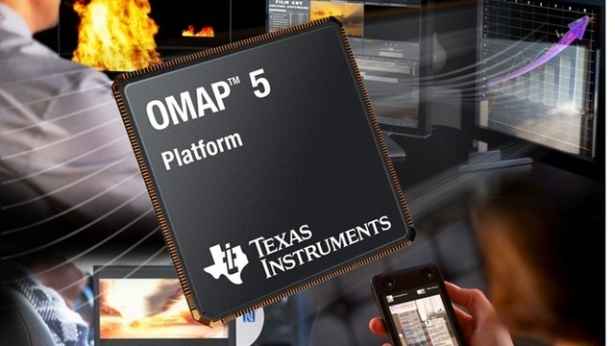TI’s OMAP 5 chips target Windows

Texas Instruments today announced its new OMAP 5 mobile platform, a super-advanced mobile chipset that will enable Kinect-like gesture-based interfaces and potentially support Microsoft’s new, ARM-based version of Windows.
OMAP 5 is the first chipset based on the brand-new ARM Cortex-A15 processor, which offers support for more than 4GB of memory and multiple operating systems virtualized in hardware, said TI OMAP product line manager Brian Carlson. The dual-core A15 (at up to 2-GHz per core) will be accompanied by a multi-core Imagination PowerVR SGX544 GPU, which supports Microsoft’s DirectX 9 and delivers five times the graphics performance of the current SGX540, he said.
“Cortex-A15 is to Cortex-A9 what Cortex-A8 was to the good old ARM11 platform,” said Remi El-Ouazzane, vice president of TI’s OMAP platform business unit.
Cortex-A8 is the chip that enabled the first real generation of super-phones, including the Motorola Droid and Apple iPhone 3GS. Cortex-A9 is the platform that is starting to appear now in hot devices like the BlackBerry Playbook and Motorola Atrix. Cortex-A15 is another leap in power.
According to Carlson and El-Ouazzane, OMAP 5 will allow mobile computers to run multiple operating systems much more easily than they do today. TI is targeting Android, Chrome OS, and Microsoft Windows, the executives said. According to a demo video and to El-Ouazzane, OMAP 5 devices could act as an Android-based smartphone when on the go and as a Windows-based desktop PC while in a dock, for instance.
“We are engaging with Microsoft for next-generation Windows,” El-Ouazzane said.
The big wow here, though, will be the interfaces. TI seems to be heavily focused on gesture-based interfaces like the Microsoft Kinect. The company will provide a special API to enable full-body and multi-body gesture interfaces. You’ll wave your hand near your smartphone to manipulate objects in virtual 3D; naturally, glasses-free 3D display and capture technologies are also included.
“The gesturing world is going to explode,” El-Ouazzane said. “There is absolutely no reason why it will not fall into the mobile space quicker than expected.”
OMAP 5 isn’t just dual-core, the executives said. With its dedicated processor cores for 2D graphics and 3D graphics, two ARM Cortex-M4 cores for general-purpose assistance, along with dedicated imaging, security, and video cores, you could think of this as a 12-core system.
[RELATED_ARTICLE]The OMAP 5 will offer three times the processing power of current cutting-edge processors, but it will also have longer battery life, Carlson said. New “Smart Reflex 3” power management technology lets TI tune its many cores to bring energy use down by 60 percent in some situations over OMAP 4, he said.
Other hot new features in OMAP 5 include USB 3.0, SATA 2, SDXC high-capacity Flash memory support, coprocessor support, a camera interface supporting 24-megapixel images, and 1080p 3D video capture at 60 frames per second. All this fits into two packages: a smaller, more expensive OMAP5430 which is only 14mm square, and a less expensive OMAP5432 which measures 17mm on a side.
If this sounds like a teeny, tiny, desktop PC, well, yeah.
TI, Qualcomm, Samsung, and now Nvidia are constantly one-upping each other in the mobile platform market. Nvidia grabbed the spotlight at CES with its Tegra 2 platform, the first widely-adopted platform to use the dual-core Cortex-A9 architecture. That eclipsed TI’s dual-core OMAP 4, which so far we’ve only seen adopted in the BlackBerry Playbook. But we expect to see many more dual-core announcements from TI, Qualcomm, and Samsung at Mobile World Congress next week.
OMAP5 will go to manufacturers in the second half of 2011, with devices appearing on shelves in the second half of 2012, Carlson said.
Editor’s Note: Check out a TI’s breakdown of the new OMAP 5 platform’s features and benefits, below:
|
Features
|
Benefit *
|
|
Two ARM Cortex-A15 cores, up to 2 GHz each |
3x higher performance to deliver the promise of mobile computing |
|
Two ARM Cortex-M4 cores
|
Low-power offload and real-time responsiveness |
|
Multi-core 3D graphics and dedicated 2D graphics |
5x higher graphics performance; accelerated and more responsive user interfaces |
|
Multi-core imaging and vision processing unit |
Next-generation computational photography experiences – face recognition, object recognition and text recognition |
|
Multi-core IVA HD video engine
|
1080p60 HD video and high performance, low bit rate video teleconferencing |
|
Advanced, multi-pipeline display sub-system |
Supports multiple video/graphics sources for composition |
|
Can support four simultaneous displays
|
Supports three high-resolution LCD displays (up to QSXGA) and HDMI 1.4a 3D display |
|
High performance, multi-channel DRAM and efficient 2D memory support |
Supports advanced use cases with multiple ARM cores and multimedia operation; provides better user experiences without lag or quality degradation |
|
TI M-Shield™ mobile security technology with enhanced cryptography support |
End-to-end device and content protection
|
|
New, high-speed interfaces
|
Supports USB 3.0 OTG, SATA 2.0, SDXC flash memory and MIPI® CSI-3, UniPort-M and LLI interfaces to support higher Wi-Fi and 4G network and HD content data rates |
|
Optimized audio, power and battery management platform solutions |
Complementary TI devices for an optimized OMAP 5 platform solution |
|
Next-generation connectivity technologies
|
HD wireless video streaming, wireless display, mobile payments and enhanced location-based services |
| *Comparative statements compare OMAP 5 platform to OMAP4430 applications processor. | |
Copyright © 2010 Ziff Davis Publishing Holdings Inc.


